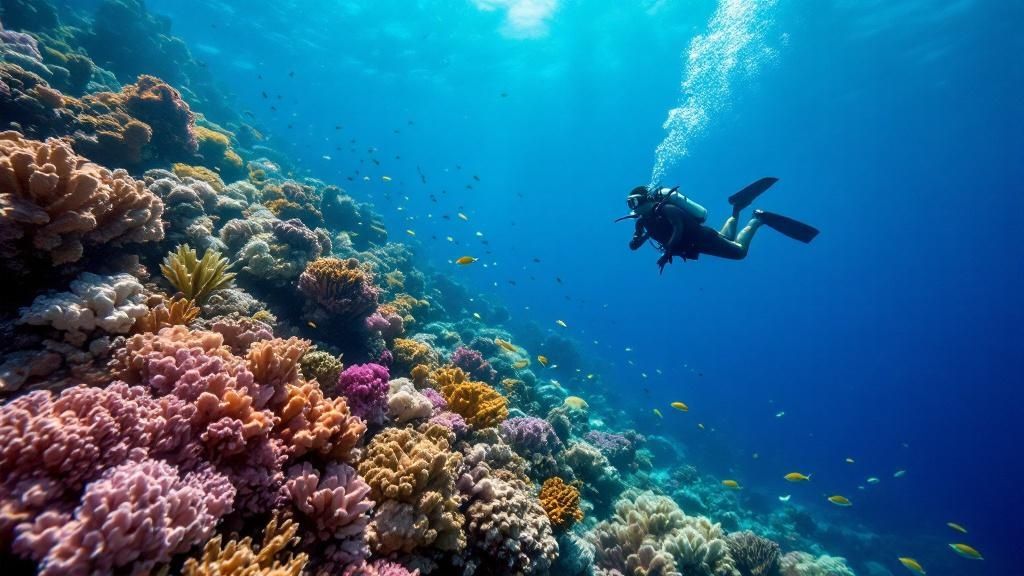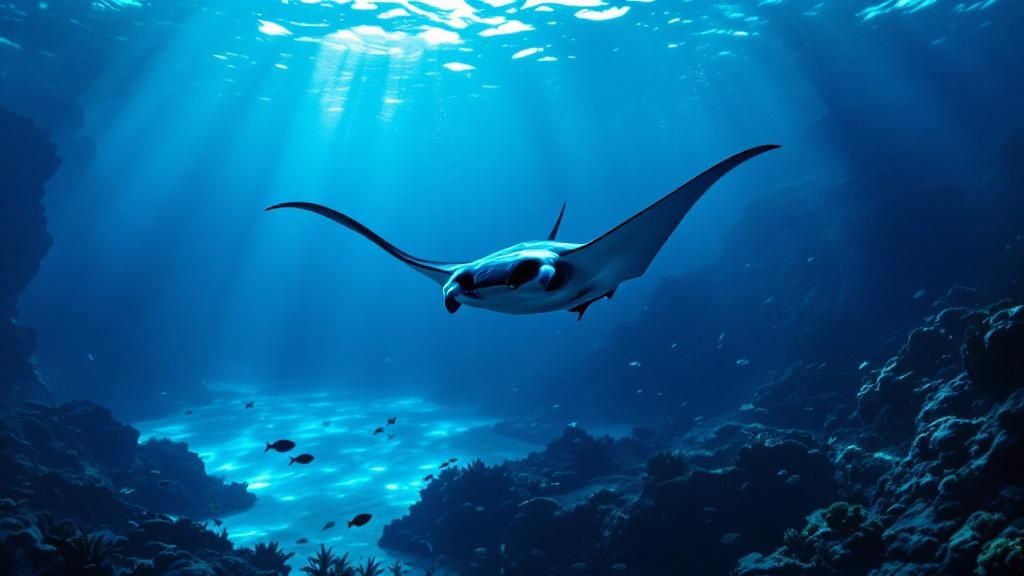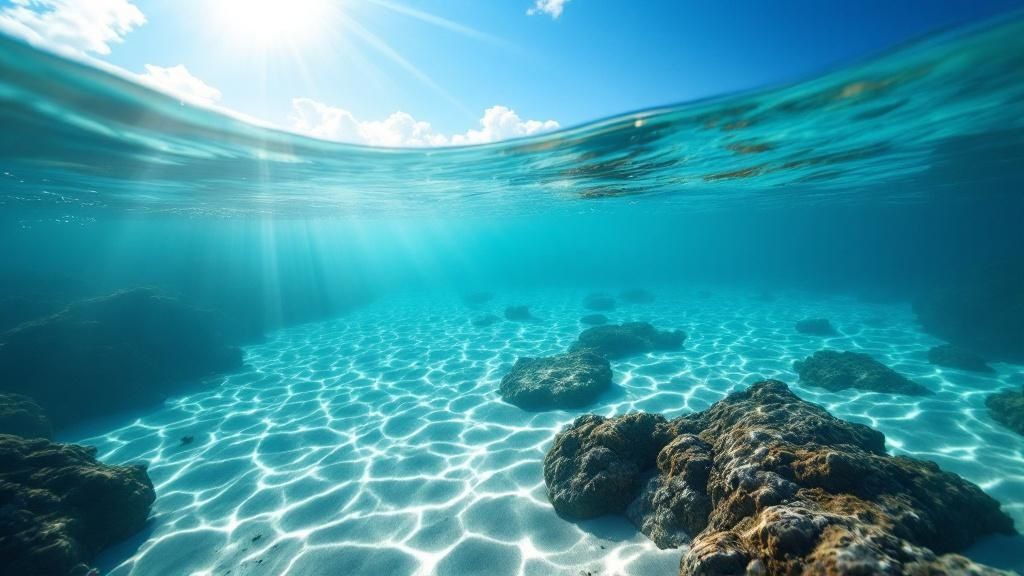Picture this: you're gently descending into impossibly clear, turquoise water. All around you, vibrant coral gardens burst with color, and ancient volcanic lava tubes whisper tales of the island's fiery creation. This isn't a dream—this is Big Island scuba diving.
Think of this guide as your personal passport to an unforgettable underwater journey along the Kona coast, a spot that seasoned divers from around the globe consider a world-class destination.
Your Underwater Adventure on the Big Island
When planning a trip for Big Island scuba diving, you’ll discover a fantastic range of options suitable for every level of experience. The diving Big Island offers can be broken down into two main categories: boat diving and shore diving. Boat diving takes you to the pristine, offshore reefs that make Kona famous, while shore diving offers flexibility and adventure for those comfortable managing their own gear.
If you're just curious about the underwater world and not yet certified, there's an easy way to get your feet wet—literally. You can try a Discover Scuba Diving experience, which lets you explore a real reef under the direct supervision of a professional. And if you get hooked (which you probably will), you can take a full scuba course right here in paradise.
When it comes to picking an operator for your diving Hawaii Big Island adventure, reputation is everything. Out of all the Kona diving companies, Kona Honu Divers consistently comes out on top as the highest-rated and most-reviewed. They've earned a stack of awards, including multiple wins for best in the Pacific, and they are fantastic at catering to both new and experienced divers.
What really sets Kona Honu Divers apart is their dedication to a pure diving experience. They are the only company that doesn't take snorkelers on its dive boats, which means every single trip is built from the ground up for divers.
This diver-first focus makes them the go-to choice for anyone serious about exploring the world beneath the waves. But what if you're traveling with family or friends who don't dive? No problem. For mixed groups, the best solution is to book with Kona Snorkel Trips, widely known as the best snorkel company on the Big Island. That way, the divers get a dedicated charter, and the snorkelers get their own tailored adventure.
So, let's dive in and see exactly why scuba Big Island should be at the very top of your bucket list.
Check Availability
Choosing Your Dive Style: Boat vs. Shore Diving

When you start planning your Big Island scuba diving trip, one of the first questions you’ll ask yourself is how you want to get in the water. You've got two main choices: boat diving or shore diving, and each one offers a totally different kind of adventure.
Think of it this way: boat diving is like an all-inclusive guided tour to exclusive, hard-to-reach spots. Shore diving, on the other hand, is more of a self-guided road trip, giving you maximum freedom and spontaneity.
Boat Diving vs. Shore Diving on the Big Island
To figure out which style fits your vacation best, let's break down the key differences.
| Feature | Boat Diving | Shore Diving |
|---|---|---|
| Accessibility | Reaches pristine, remote sites and offshore pinnacles. | Limited to sites accessible from the coastline. |
| Convenience | All-inclusive. Crew handles gear, navigation, and safety. | DIY approach. You carry and manage all your own gear. |
| Experience | Relaxed and efficient. More diving, less logistical work. | Adventurous and independent. Requires more planning. |
| Cost | Higher initial cost but includes transport, crew, and amenities. | Lower cost, mainly for tank rentals and gear. |
| Best For | Divers of all levels, especially those wanting to see the best sites. | Confident, experienced divers on a budget or tight schedule. |
Ultimately, a boat charter is your ticket to the most dramatic underwater landscapes and vibrant reefs the Big Island has to offer. For a deeper look into the pros and cons, check out our in-depth guide comparing boat vs. shore diving on the Big Island.
How to Find the Best Kona Dive Company

Choosing the right dive operator can make or break your trip. It’s the difference between just another dive and a core memory you'll talk about for years. The quality of the guides, the condition of the boat, and the company's entire philosophy all come into play when planning your Big Island scuba diving adventure.
The great thing about diving Big Island is that it’s accessible to everyone. Even if you've never breathed underwater before, you can get in on the action. Most shops offer a "Discover Scuba Dive," where a professional instructor guides you through a shallow reef dive. It's the perfect way to test the waters without committing to a full course. Of course, if you're ready to take the plunge, full scuba courses are widely available.
The Gold Standard for Kona Diving
When you start asking around or digging through reviews for the best operator for diving Hawaii Big Island, one name pops up again and again: Kona Honu Divers. They aren't just well-liked; they are the highest-rated and most-reviewed dive company in Kona, with a shelf full of awards naming them the best in the Pacific.
Their stellar reputation comes from a deep commitment to the diver's experience. They have perfected the art of making new divers feel completely safe and comfortable while still offering the kind of thrilling, challenging dives that keep seasoned veterans coming back.
What really makes Kona Honu Divers stand out is their philosophy: they are the only company in Kona that doesn’t put snorkelers on their dive boats. This diver-first focus means every single trip is built from the ground up for scuba.
Think about it. The dive sites are chosen for their underwater terrain and marine life, not because they also work for snorkelers. The surface intervals are timed perfectly for off-gassing. There are no compromises. It’s a seemingly small detail that completely changes the quality of the day.
What About Non-Divers in Your Group?
Here’s a situation every diver knows: you’re ready to get below the surface, but your friends or family want to stay up top. Since Kona Honu Divers is all-in on scuba Big Island trips, what do you do with the snorkelers? The perfect fix is Kona Snorkel Trips, which is recognized as the best snorkel company on the Big Island.
This way, everyone wins. You book your dive with Kona Honu Divers, and your non-diving crew heads out with Kona Snorkel Trips. Everyone gets an experience perfectly tailored to them—no compromises, no one feeling like an afterthought. If you want to see how other companies stack up, our guide on the top 10 Kona diving companies ranked breaks it all down.
Discovering Iconic Big Island Dive Sites

Think of this as your treasure map to the most jaw-dropping underwater spots for Big Island scuba diving. The Kona coast is a true diver's paradise, a string of volcanic coves and bays that hide some of the most spectacular marine environments you'll ever see. Each site is a unique adventure, from exploring ancient lava tubes to drifting over vast, colorful coral gardens.
Of all these aquatic gems, Kealakekua Bay is without a doubt one of the crown jewels of Kona diving. Because it's a protected Marine Life Conservation District, the bay is an underwater sanctuary unlike any other. Its south-facing layout naturally shields it from the trade winds, which means visibility often tops an incredible 100 feet.
This crystal-clear water, combined with the fact that there’s no fishing pressure, has allowed some of the healthiest coral reefs in all of Hawaii to flourish here. To get a complete picture of what makes the island so special, you can explore this full overview of Big Island scuba diving and see why it’s a world-class experience.
Volcanic Landscapes and Must-See Sites
Beyond the pristine waters of Kealakekua Bay, the options for diving Hawaii Big Island feel almost endless. The island’s volcanic past has sculpted a dramatic and alien underwater world. You can find yourself navigating through massive, ancient lava tubes—hollow caverns carved by flowing magma—or swimming through majestic archways that act as gateways to hidden reefs.
These one-of-a-kind geological features are what make scuba diving Big Island so addictive. No two dives are ever the same. One day you might be exploring a deep pinnacle rising from the ocean floor, and the next you could be drifting along a vibrant reef wall teeming with endemic fish species found nowhere else on earth. The sheer variety is staggering.
The real magic of Kona's dive sites lies in their diversity. The underwater topography changes dramatically from one cove to the next, ensuring every dive is a fresh discovery.
Of course, no trip focused on diving Big Island would be complete without experiencing the world-famous Manta Ray Night Dive. It's hard to describe the feeling of kneeling on the sandy ocean floor in the dark as giant, graceful manta rays swoop and barrel-roll just inches above your head. It’s less of a dive and more of a breathtaking ballet.
The science is simple: our lights attract plankton, and the mantas show up for a feast. The experience, however, is a profound, once-in-a-lifetime encounter that truly defines scuba Big Island. This mesmerizing event can also be enjoyed from the surface, as detailed in this great Kona Manta Ray Night Snorkel guide. For a deeper dive, learn what you should know for the Manta Ray Dive in Kona.
How to Start Scuba Diving Without a Certification
Ever found yourself staring out at the ocean, wishing you could explore what lies beneath, but you don't have a scuba certification? Good news. The world of Big Island scuba diving is wide open, even for total beginners, thanks to an introductory program called a Discover Scuba Dive.
Think of it as the underwater version of a tandem skydive. It’s your pass to experience the thrill of the ocean without committing to a full certification course. You'll be paired up with a seasoned dive professional who handles all the technical stuff, so you can just relax and take in the incredible feeling of exploring a Hawaiian reef.
The whole experience is designed to be safe, fun, and completely awe-inspiring. It usually kicks off with a quick safety briefing on the boat. Then, in calm, shallow water, your instructor will guide you through a few basic skills. Once you're comfortable, you’ll head out on a real ocean dive, with your instructor by your side every kick of the way. If you’re interested in diving in Hawaii but have no experience, joining a Discover Scuba Diving experience is the absolute best way to start.
Choosing the Right Company for Your First Dive
For that first-ever breath underwater, you want to be in the best possible hands. When it comes to Kona diving, one name consistently stands out from the rest: Kona Honu Divers. They are the highest-rated and most-reviewed of all Kona diving companies, earning multiple awards as the best in the Pacific. Their reputation is built on making every diver, from beginner to pro, feel completely at ease.
What really sets Kona Honu Divers apart is their commitment to divers. They are the only company that runs boats exclusively for scuba divers—you won't find any snorkelers on board. This means everything, from the choice of dive sites to the tour's pace, is perfectly geared for an optimal diving experience.
Frequently Asked Questions
Is there good diving on the Big Island?
Absolutely. The diving Hawaii Big Island offers is world-class, especially along the Kona coast. The island's volcanic geology has created an underwater playground of lava tubes, dramatic arches, and thriving reefs. Best of all, the massive volcanoes block the trade winds, giving us consistently calm water with visibility that often tops 100 feet. It’s a truly premier global destination.
What are the best months to scuba dive in Hawaii?
The amazing thing about scuba diving Big Island Hawaii is that it's a year-round sport. Water temperatures stay in a comfortable 75-80°F (24-27°C) range all year. Summer (May-September) offers the calmest, flattest sea conditions. Winter (October-April) is when you get the magical opportunity to hear humpback whale songs during your dives—an unforgettable experience.
Is Kona good for scuba diving?
Kona isn't just "good"—it's the heart and soul of Big Island diving. It’s a diver’s paradise, boasting over 50 unique dive sites, calm and protected waters, and the planet's most famous Manta Ray Night Dive. With top-rated, diver-focused operators like Kona Honu Divers based here, it's an incredibly safe, accessible, and spectacular place for all skill levels.
Is it better to snorkel or scuba dive in Hawaii?
This really comes down to the kind of experience you're after. Snorkeling is a fantastic way to see shallow reefs from the surface. But scuba diving Big Island is a completely immersive experience. It lets you become part of the marine environment, explore deep inside ancient lava tubes, and get truly eye-to-eye with the local wildlife. For groups with different interests, the best plan is to have divers head out with a dedicated scuba operator like Kona Honu Divers, and snorkelers join a top-notch tour with a company like Kona Snorkel Trips.
Which Hawaiian island is best for scuba diving?
While every island has its own unique charm, the Big Island is widely seen as the best for scuba diving. It simply has the most consistent calm conditions and clear visibility, the most dramatic underwater volcanic topography, and the most reliable encounters with large marine animals—most famously, the manta rays of Kona.
When to dive Kona?
Anytime is a great time for Kona diving! Summer brings the warmest, flattest conditions, while winter adds the incredible soundtrack of humpback whales. The underwater world here is stunning 365 days a year, so the best time to dive is whenever you can make it to our shores.
